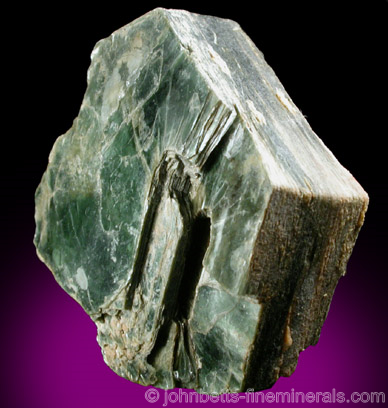The chlorite Mineral Group

Chlorite is the group name for about 10 related minerals. However, the term Chlorite can be used both to describe the group in general, or as a specific term to describe any green member of the Chlorite group whose exact identity is not practical to be determined. Although Chlorite is not recognized as an individual mineral species by the IMA, mineral collectors still refer to it by its
traditional name, except when specifically referring to the individual member minerals such as Clinochlore, Chamosite, and Cookeite.
Chlorite is very common, and is often an uninteresting green mineral coating the surface of more important minerals. However, there are some crystal forms and varieties that are attractive on their own right. Chlorite also forms as inclusions within other minerals, especially Quartz, where it makes the host mineral green and may even cause phantom growths.
Chemical Formula
Below is a simple formula encompassing the common members of the Chlorite Group:
(Mg,Fe,Li)6AlSi3O10(OH)8
The formula for the three most common individual group members are:
Cookeite: LiAl5Si3O10(OH)8
Clinochlore: (Mg,Fe2+)5Al2Si3O10(OH)8
Chamosite: (Fe2+,Mg)5Al2Si3O10(OH)8
Color
Light to dark green, grayish-green, black. Some rarer varieties are white, yellow, brown, pink and purple.
Crystal System
Monoclinic
Properties
Streak
White |
Hardness
2 - 2.5 |
Transparency
Transparent to translucent |
Specific Gravity
2.6 - 3.3 |
Luster
Vitreous, pearly, or dull |
Cleavage
1,1 |
Fracture
Uneven |
Tenacity
Thin flakes are flexible but not elastic. |
Other ID Marks
Has a slightly greasy feel.
|
Noteworthy Localities
Although Chlorite is a fairly common mineral and found worldwide, localities producing material worthy of collections are surprisingly limited. Maderanertal, in Uri, Switzerland, is famous for its shiny green Chlorite coatings on Quartz and Adularia. Many interesting Quartz phantoms caused by Chlorite have been found there.
In the U.S., Excellent pseudomorphs of Chlorite after Garnet come from Michigamme, Marquette Co., Michigan. Chlorite as a matrix to nice Magnetite and Pyrite crystals comes from Chester, Windsor Co., Vermont. Good crystals come from the Green Mountain Mine, Day Book, Yancey Co., North Carolina. Strange pseudomorphs of Chlorite after all types of minerals came from the Tilly Foster Mine, Brewster, Putnam Co., New York.
Other localities include Trumbull, Fairfield Co., Connecticut; the Warren Brothers Quarry, Acushnet, Bristol County, Massachusetts; and the New Idria District in the Diablo Range, San Benito Co., California.
Distingushing Similar Minerals
Muscovite and other micas - Are more elastic then Chlorite.
Talc - Softer (1).